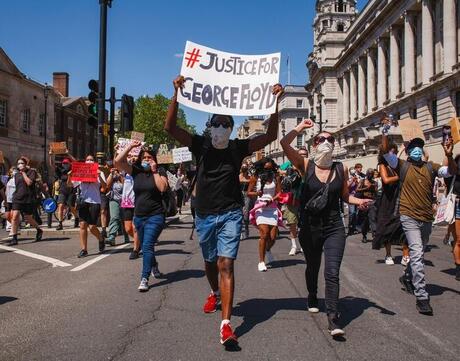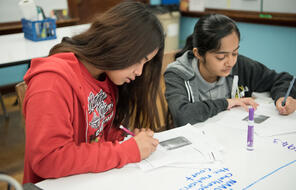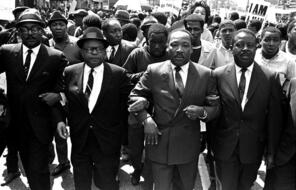Play Sky News’ video Black Lives Matter: Why do the George Floyd protests resonate so strongly in the UK? for your students.
Then, reflect with students:
- Over one hundred thousand people have taken to the streets in the UK since the murder of George Floyd. What reasons do they give for doing so in the video?
- The journalist interviewing people asks a woman about why people are protesting during a pandemic. What is her response? What does this tell us about racism in the UK?
- In the video, people discuss how racial discrimination plays out in the UK. What do they say about this? What impact does such discrimination have?
- Angela Davis’ statement ‘in a racist society it is not enough to be non-racist, we must be anti-racist’ has been widely circulated during these protests. What does this tell us about what needs to be done to challenge injustice? Whose responsibility is it?
Then, share the following information concerning the systemic racism in the criminal justice system and police activity in the UK:
The systemic racism in the UK impacts the lives and opportunities of all ethnic minorities, but black people, in particular, appear to be at greater risk of being targeted by police. During the COVID-19 lockdown period, black people in London were twice as likely to be fined for lockdown breaches than white people.
This biased policing of black people on the streets is also evident in how stop and search is deployed. Black people are far more likely to be stopped and searched than their white counterparts: a recent publication from the Ministry of Justice showed that in 2018-2019 in England and Wales, there were ‘4 stop and searches for every 1,000 White people, compared with 38 for every 1,000 Black people.’
During this period, then, black people were nine times more likely to be stopped and searched. Given that 17% of stop and searches lead to arrest and 13% to some other kind of action, this bias puts black people more at risk of entering the criminal justice system than their white counterparts.
It is no surprise then that black people are disproportionately represented in UK prisons. In 2017, the Lammy Review found that there was ‘greater disproportionality in the number of black people in prisons [in England and Wales] than in the United States.’
Despite accounting for just 3% of the population of England and Wales, black people accounted for 12% of the UK prison population.
Distressingly, black people, as the 2017 Angiolini Review highlighted, are also more likely to have died in police custody as a consequence of being subjected to ‘dangerous restraint techniques and excessive force’ than white people.
In addition to the discriminatory deployment of stop and search powers by police and the, as highlighted by the Lammy Review, ‘overt discrimination, in parts of the justice system,’ black people also experience discrimination in other areas, which leaves them more vulnerable to ending up in prison. Black Caribbean students are three times more likely to be excluded from school than their white counterparts.
This is concerning in and of itself as young black people are losing out on education, but it becomes all the more concerning when you learn that, according to a 2012 report by the Ministry of Justice, the majority of people who end up in the prison system have been excluded from school.
Another area that impacts the disproportional representation of black people in prison is social deprivation: according to a 2018 publication by the Office of National Statistics, ‘Black people were most likely to live in the most income-deprived neighbourhoods (23.3% lived in the most income-deprived 10% of neighbourhoods) and White people were least likely to (8.7% did so).’
Growing up in poverty is another factor which increases one’s chance of going to prison.
As is evident from the above statistics, systemic racism in the UK is a deeply ingrained problem that greatly reduces the life opportunities for black people and leaves them at greater risk in the hands of police. This oppression needs to be actively addressed or more people will continue to live in fear and to suffer for something as arbitrary as the colour of their skin.
Use the following questions to reflect on the information above with your students:
-
How has it made you feel learning about the statistics concerning systemic racism in Britain?
-
Is there anything that you found particularly surprising or troubling in the reading?
-
What impact has the reading had on how you view the George Floyd and Black Lives Matter protests in the UK?
-
People have been campaigning to challenge systemic racism in the UK in a range of ways. Some organisations have focused their efforts on schools: The Black Curriculum, for example, is a social enterprise that campaigns for black British history to be taught in schools, whilst Show Racism the Red Card is an educational charity that has delivered workshops to students and used high profile footballers to spread its anti-racist messages. Other organisations have focused their efforts on putting pressure on the government: for example, the Runnymede Trust, a charity and independent race equality think tank, has conducted research and analysis on race inequality in the UK to start debate and policy engagement.
What do you think should be done to challenge systemic racism in the UK?
You might also have students synthesize what they have learned from this reading by having them create an iceberg diagram. At the top of the diagram, students can write ‘disproportionate number of black people in prison.’ Next to the bottom part of the diagram (under the water), students should write their answers to these questions:
Finally, ask students to share their diagrams. (If students drew their own diagrams, they can take a photo to share.)





















